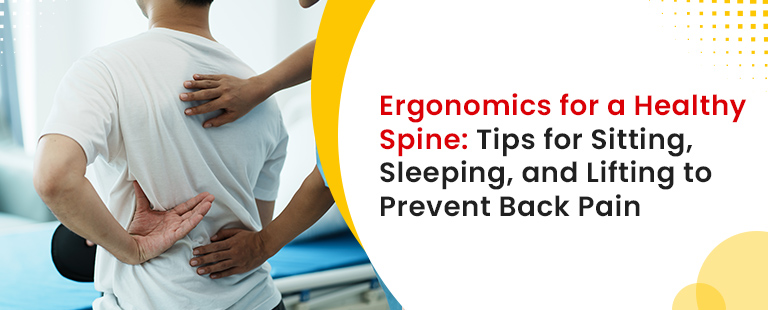Ergonomics for a Healthy Spine: Tips for Sitting, Sleeping, and Lifting to Prevent Back Pain
Do you spend most of the day sitting at the desk, whether in an office setting or working remotely from home? Doesn’t the discomfort worsen as the day progresses, making it increasingly challenging to focus on your tasks? When you leave the office, you’re left with a nagging ache that lingers well into the evening. If so, then this blog is for you!
Prolonged sitting can damage our spine, but with the right ergonomics, this can be prevented. Imagine a day at work without constant back discomfort. Creating a spine-friendly environment prevents back pain and promotes overall well-being. Here are a few tips for healthy spine ergonomics that can bring you the relief you’ve longed for.
The Right Sitting Posture
One key element of a spine-friendly workstation is an ergonomic chair with adequate lumbar support. This support helps maintain the lower back’s natural curve, reducing strain on the spine. But it’s not just about the chair; it’s about you.
The advantage of adjustable chairs is that they allow you to customize the height and tilt to achieve comfortable sitting, putting you in control of your health. Additionally, positioning the computer monitor at eye level helps prevent neck strain by promoting a neutral posture you can maintain.
Safe Lifting Techniques
Whether it’s moving furniture during a household renovation or lifting boxes at work, improper lifting techniques can lead to serious back injuries. Improper lifting techniques are a leading cause of back injuries, often resulting in severe pain and long-term consequences.
Always bend your knees and keep your back straight when lifting heavy things. This way, you use the strong muscles in your legs instead of straining your back. Avoid twisting your body while lifting by moving your feet instead of turning your torso. If something is too heavy or awkward to lift alone, ask for help or use tools like dollies or carts.
Right Sleeping Positions
We nearly spend more than one-third of our lives in bed, which means that the quality of our mattresses and pillows directly impacts our spinal health. Many people overlook the importance of proper sleep posture and the impact it has on spinal health.
Invest in a mattress that gives good support and fits your body’s curves. A medium-firm mattress is usually best because it balances support and comfort. Also, pick a pillow that keeps your head and neck aligned with your spine.
Whether you like a regular pillow or one made of memory foam, make sure it supports your spine well, even if it’s not super soft. Remember, a good night’s sleep is essential for good spinal health and overall well-being.
Simple Adjustments For Everyday Tasks
Imagine this scenario: you are hunched over the kitchen counter, washing dishes after dinner. With each repetitive motion, a dull ache creeps into your lower back, increasing the strain and discomfort. In this case, investing in adjustable kitchen countertops and supportive mats helps reduce the strain on your back.
Whether you’re vacuuming, gardening, doing laundry, or washing dishes and for any daily tasks, using ergonomic principles can stop back pain before it starts. When you’re vacuuming or mopping, use tools with long handles to avoid bending down too much. Bend your knees and keep your back straight to protect your spine.
Use gardening tools with cushioned and long handles to make gardening easier on your back and joints. When doing laundry, use a washing machine with a door in the front so you don’t have to bend and twist too much when loading and unloading clothes.
These are just a few simple adjustments or things to keep in mind, among many others, for a healthy spine during your daily tasks.


